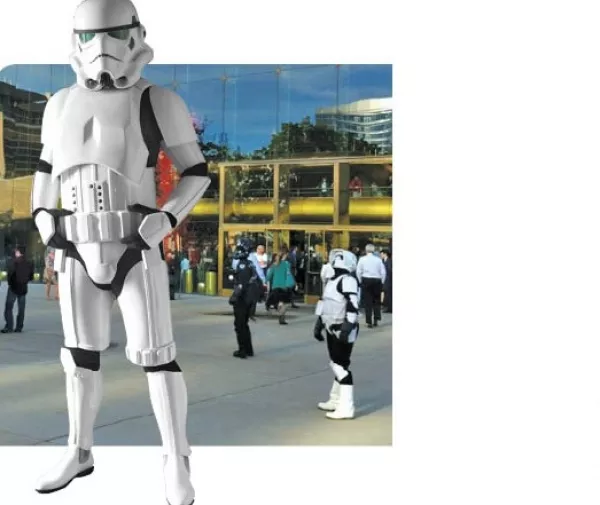
One has certain preconceptions about appropriate attire for the symphony. A Wookiee costume probably isn’t the first thing that comes to mind.
Yet there he was, in the lobby of Abravanel Hall: Chewbacca himself, or perhaps some look-alike cousin wearing the bandolier to make a few extra bucks. There were Imperial Stormtroopers, as well, and Boba Fett, all posing for photos while grinning children—and more than a few grinning adults, some of them sporting their own costumes—milled around in the lobby of Abravanel Hall. High culture, meet geek culture. Concerto, meet Comic-Con.
The occasion was a Utah Symphony program titled The Magical Music of John Williams, part of the Utah Symphony’s Family Series—as you’d only need to observe the audience demographics to conclude. Families with youngsters nearly outnumbered other adults, dropping the average spectator age of a typical symphony performance by decades. Outside of a field trip, you can be certain it was the first time many of the attendees ever set foot in a symphony hall.
Guest conductor Vladimir Kulenovic clearly understood his audience as he offered scripted introductions to most of the evening’s selections. More than half of the program consisted of Williams’ iconic movie scores, from Superman and Harry Potter to Raiders of the Lost Ark and multiple pieces from the Star Wars films. They were interspersed with several pieces by other composers, some intended to draw attention to influences on Williams’ work, others simply fitting in their heroic themes. With humor and enthusiasm, Kulenovic drew young listeners into the notion that Williams’ familiar orchestral pieces were part of a larger historical framework of works created to illustrate a story, or evoke a sense of wonder.
There was plenty for a novice to learn. Kulenovic asked listeners to see if they could identify the movie that a specific selection was from, only to play Gustav Holst’s 1916 “Mars, the Bringer of War” from The Planets, bridging the distance between movie music and the orchestral works that preceded the advent of sound movies. The introduction to Richard Strauss’ Also Sprach Zarathustra and Wagner’s “The Ride of the Valkyries” both appealed to movie nerds who know them best from 2001: A Space Odyssey and Apocalypse Now, respectively, and awed their kids with their grandeur. And the side-by-side comparison of Williams’ famously ominous Jaws theme with the fourth movement of Dvo%u0159ák’s New World symphony provided a remarkable lesson in either unconscious influence, or bold artistic “re-purposing.”
It’s a savvy approach to bringing live orchestral performance—and arts education—to an audience that hears such music performed all the time in popular films, yet might somehow think of a symphony evening as a fusty relic for their parents, or grandparents. Still, rank & file symphony supporters often have an ambivalent attitude about pops concerts and other similar programs that expand the repertoire beyond the Old Masters. While the John Williams program was officially a sold-out performance, dozens of empty seats could be spotted throughout Abravanel Hall. Plenty of season-ticket holders clearly didn’t consider a program of this kind one meant for them.
In a sense, they would be right—but they’d also be missing a unique opportunity. For nearly two hours, an audience full of children and youth sat enthralled, listening to an orchestra perform works both larger-than-life and more intimate, even dissonant. They stood and cheered, bringing Kulenovic back for a second bow. For anyone who truly loves the arts, and who wants to see them supported into subsequent generations, it was a heart-warming occasion.
It was also a reminder that every art form needs its “gateway drug.” Nobody ever fell in love with reading by sitting down with Proust in grammar school, nor did Truffaut or Bergman ever usher a kid into the joy of going to the movies. Holiday productions of The Nutcracker or A Christmas Carol may feel like sops to the Philistines, but they provide a rare opportunity for young viewers to experience the energy that comes from seeing dancers and actors perform live. If supporters of the arts have a love/hate relationship with pop-art crowd-pleasers in various media, it should really lean toward the “love” side of that equation.
It’s crucial that those who claim to support high art can recognize the power of an evening like this one, and not see it as some sort of pandering because the people in formal wear were sharing the auditorium with the woman in the Princess Leia getup or the ersatz Professor Snape. Every Gen X-er who feels an involuntary tingle at the blast of brass that heralds the opening Star Wars crawl knows instinctively the power of symphonic music to stir the soul. If a few kids leave inspired to listen to other soul-stirring works beyond the ones they hear in their local multiplexes, that’s a powerful force indeed.